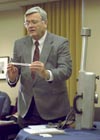| Click on photos below to download newspaper-quality photos. |
 |  | At a Feb. 11,
2002, news conference on the UC Davis campus, Prof. Thomas Cahill explains the mechanics of the DELTA Group air monitor.
(Photo courtesy of UC Davis) |
| |  | At a Feb. 11, 2002, news conference on the UC Davis campus, Prof. Thomas Cahill explains the mechanics of the air
collecting strips.
(Photo courtesy of UC Davis) |
| |  | At a Feb. 11, 2002, news conference on the UC Davis campus, Prof. Thomas Cahill explains the mechanics of the collapse of the World Trade Center buildings.
(Photo courtesy of UC Davis) |
In the most
thorough analysis yet of the dust and smoke blown through lower Manhattan after the collapse of the World Trade Center, researchers at the University of California, Davis, today described unprecedented clouds of very fine particles that should be considered in evaluating rescue workers' and residents' health problems.
Based on their findings, the UC Davis researchers also recommended specific cleaning methods for contaminated apartments, offices, schools and other indoor spaces.
"No one has ever reported a situation like the one we see in the World Trade Center samples," said UC Davis researcher Thomas Cahill, Ph.D., an international authority on the constituents and transport of airborne particles. "The air from Ground Zero was laden with extremely high amounts of very small particles, probably associated with high temperatures in the underground debris pile. Normally, in New York City and in most of the world, situations like this just don't
exist."
Cahill, a UC Davis professor emeritus of physics and atmospheric sciences and a research professor in applied science, heads the UC Davis DELTA Group (for Detection and Evaluation of Long-range Transport of Aerosols), a collaborative association of aerosol scientists at several universities and national laboratories. The DELTA Group has made detailed studies of aerosols from the 1991 Gulf War oil fires, volcanic eruptions, global dust storms, and most recently Asia.
The Manhattan air samples were collected at the request of a U.S. Department of Energy scientist from Oct. 2 through mid-December, by a DELTA Group air monitor placed on a rooftop at 201 Varick St., one mile north-northeast of the trade center complex.
The samples were collected continuously in eight separate size modes from coarse (12 micrometers diameter) to ultra-fine (0.09 micrometers diameter). Regional meteorology showed that the site at Varick Street could have received material from the World Trade Center site about half the time.
The samples were periodically shipped back to Davis, where the DELTA Group analyzed the samples for size, shape and composition. They used a suite of seven techniques including synchrotron-induced X-ray fluorescence (at DOE's Advanced Light Source at Lawrence Berkeley Laboratory), scanning transmission ion microscopy and proton elastic scattering analysis (at DOE's Lawrence Livermore National Laboratory), and soft beta mass measurements and scanning electron microscopy (at
UC Davis).
"The UC Davis DELTA Group's ability to measure and analyze particle size, composition and time continuously, day and night, is unequaled," Cahill said.
All analyses were done on a volunteer basis and will be available as public documents. We report today on the data from Oct. 2 through Oct. 31, 2001.
Airborne particles and human health
In general, there are myriad ways that materials released into the air can affect human health. What the particles are made of matters; so do size, shape and quantity.
The DELTA team analyzed the samples for the unique chemical and physical signatures of dozens of substances, including elements from concrete and glass, such as silicon; from burning fuel oil, such as sulfur, vanadium and nickel; and from burning computers and electrical systems, such as lead. They also looked for organic, or carbon-based, compounds from burning wood, plastic and carpets. And they tested for glass shards and asbestos.
Some of these materials are known to cause health problems in some people when they are inhaled in sufficient amounts. Sulfur, for example, can irritate lung tissues. Lead can damage the central nervous system. Some carbon-based compounds can cause cancer. So can the mineral asbestos.
Just as the composition of inhaled particles can affect health, so can size.
The team analyzed the particles by size in eight ranges from coarse (12 micrometers to 5 micrometers in diameter) to very fine (0.24 micrometers to 0.09 micrometers in diameter). Most of the ultrafine mode (particles less than 0.1 micrometers) was not collected.
Coarse particles are typically filtered by the nose or coughed out of the throat and upper lungs. They can irritate the mucous membranes, causing coughs and nosebleeds. In some individuals, they can cause allergic reactions such as dry eyes; nose, throat and skin irritation; coughing, sneezing and respiratory distress. They can also cause breathing problems or aggravate pre-existing breathing problems, such as asthma.
However, very fine particles can travel deep into human lungs. Such small particles may have no immediate apparent health effects in moderate concentrations, but they typically are removed from the lungs through the bloodstream and heart, increasing the possibility of health impacts.
There are no established safe limits for inhaled very fine particles. The closest reference is the U.S. EPA "PM2.5" standard, which limits the allowable mass of airborne particles in the size range 2.5 micrometers to 0 micrometers. That standard is based on health studies of typical air samples, in which very fine particles are a small fraction of the total mass.
In contrast, in the World Trade Center samples analyzed at UC Davis, the very fine particles are a large fraction of the total mass.
In a news conference today, the DELTA researchers described key findings in these categories: very fine particles, coarse particles, metals, asbestos and glass.
Very fine particles
There were numerous events when bursts of wind lasting six to eight hours carried unprecedented amounts of very fine particles to the sampling site.
In the largest spike, the DELTA Group analysis found 58 micrograms per cubic meter of very fine particles in one 45-minute period -- "an extremely high peak," Cahill said.
Cahill said the very fine particles contained high levels of sulfur and sulfur-based compounds, which in early analyses appear to have been dominated by sulfuric acid. The very fine particles also contain high levels of very fine silicon, potentially from the thousands of tons of glass in the debris.
Cahill noted that even those large amounts were likely to be smaller than those present at Ground Zero and some other parts of Lower Manhattan, since weather data show that typically only part of the dust clouds traveled directly over the sampling site.
"Even on the worst air days in Beijing, downwind from coal-fired power plants, or in the Kuwaiti oil fires, we did not see these levels of very fine particulates," Cahill said. The amounts of very fine particles, particularly very fine silicon, decreased sharply during the month of October.
Coarse particles
Similar to the high concentrations of very fine particles, virtually all the air samples from the trade center site carried high concentrations of coarse particles -- those about 12 micrometers to 5 micrometers in diameter.
"These particles simply should not be there," Cahill said. "It had rained, sometimes heavily, on six days in the prior three weeks. That rain should have settled these coarse particles." The finding suggests that coarse particles were being continually generated from the hot debris pile. This observation is at least qualitatively supported, for while they are still being analyzed, the coarse particles appear to be coated with combustion products, including soot, Cahill said.
Metals
Many different metals were found in the samples of very fine particles, and some were found at the highest levels ever recorded in air in the United States.
However, there are few established safety guidelines for airborne metals. One metal for which there is a guideline, lead, was present at low levels in fine and very fine particles.
Some of the metals for which there are no guidelines that were present in very fine particles in relatively high concentrations were iron, titanium (some associated with powdered concrete), vanadium and nickel (often associated with fuel-oil combustion), copper and zinc. Mercury was seen occasionally in fine particles but at low concentrations. Many of those metals are widely used in building construction, wiring and plumbing. Some are common in computers.
The metal content of the coarse particles is still being analyzed.
Asbestos and glass
Although some asbestos was used in the buildings for fireproofing and in floor tiles, and the DELTA group checked for it carefully using the electron microscope, they found very few asbestos fibers, even in the very fine particles.
Some particles that appeared to be glass were seen, but they were not in the form of long shards, which can mimic asbestos fibers.
Clean-up recommendations
All evidence indicates that ambient air in New York City now is little influenced by the World Trade Center collapse, especially since the fires are out and the debris pile has cooled.
However, the presence of large amounts of very fine particles as late as October means that indoor clean up should be done carefully, Cahill said. Very fine particles will have penetrated crevices and fabrics in a way normal dust doesn't. And they are easily re-suspended, which re-exposes the room's occupants to them.
Cahill strongly supports the recommendations made by the New York Department of Health regarding washing with water, and said:
-- Don't use vacuum cleaners or brooms because they re-suspend particles. Do use wet rags, mops and wet-vacuum-type cleaners.
-- Wipe all surfaces, including window blinds, picture tops and door frames, with wet rags.
-- Drapes and curtains should be washed or dry-cleaned. Furniture fabrics should be steam-cleaned. Carpets should be wet-cleaned.
-- Use high efficiency electrostatic or HEPA air filters in furnaces and air conditioners.
-- Keep humidity reasonably high indoors, to keep very fine particles from floating around.